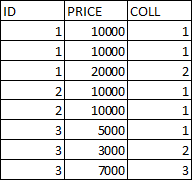- Home
- /
- Programming
- /
- SAS Procedures
- /
- how to create new group/type variable
- RSS Feed
- Mark Topic as New
- Mark Topic as Read
- Float this Topic for Current User
- Bookmark
- Subscribe
- Mute
- Printer Friendly Page
- Mark as New
- Bookmark
- Subscribe
- Mute
- RSS Feed
- Permalink
- Report Inappropriate Content
I want to create the new group/type variable. I have variables ID and PRICE and want to create the variable COLL.
So for each ID i want the type variable COLL, to check whether the price is still the same. So my final table will be:
How can I do it in proc data or proc sql?
Accepted Solutions
- Mark as New
- Bookmark
- Subscribe
- Mute
- RSS Feed
- Permalink
- Report Inappropriate Content
Here you go, do not for future posts, put test data in the form of a datastep, as given below:
data have; input id price; datalines; 1 1000 1 1000 1 2000 2 1000 2 1000 3 5000 3 5000 3 7000 ; run; data want; set have; by id price; retain coll; if first.id then coll=1; else if first.price then coll=coll+1; run;
- Mark as New
- Bookmark
- Subscribe
- Mute
- RSS Feed
- Permalink
- Report Inappropriate Content
Here you go, do not for future posts, put test data in the form of a datastep, as given below:
data have; input id price; datalines; 1 1000 1 1000 1 2000 2 1000 2 1000 3 5000 3 5000 3 7000 ; run; data want; set have; by id price; retain coll; if first.id then coll=1; else if first.price then coll=coll+1; run;
- Mark as New
- Bookmark
- Subscribe
- Mute
- RSS Feed
- Permalink
- Report Inappropriate Content
Hi @vonsel,
If prices can change in both directions (as is the case for ID 3 in your sample data), you need to add the NOTSORTED option to the BY statement: by id price notsorted;
Here's a minor variant of RW9's solution:
data want;
set have;
by id price notsorted;
coll+first.price;
if first.id then coll=1;
run;Obviously, the numbering in COLL depends on the sort order of the observations. So, I hope you have an additional variable in your real data which determines the sort order within each ID (or you have good reason to believe that the existing sort order is correct).
- Mark as New
- Bookmark
- Subscribe
- Mute
- RSS Feed
- Permalink
- Report Inappropriate Content
Thanks a lot, both solutions work.
April 27 – 30 | Gaylord Texan | Grapevine, Texas
Registration is open
Walk in ready to learn. Walk out ready to deliver. This is the data and AI conference you can't afford to miss.
Register now and lock in 2025 pricing—just $495!
Learn the difference between classical and Bayesian statistical approaches and see a few PROC examples to perform Bayesian analysis in this video.
Find more tutorials on the SAS Users YouTube channel.
SAS Training: Just a Click Away
Ready to level-up your skills? Choose your own adventure.



